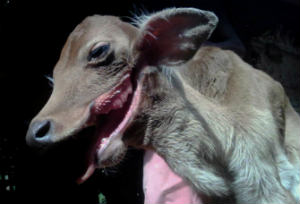Beaver Hybrids
Family Castoridae
Mammalian Hybrids
EUGENE M. MCCARTHY, PHD GENETICS, ΦΒΚ
Castor canadensis [American Beaver] (2n = 40)
× Canis familiaris [Domestic Dog] An old news notice in the Aspen, Colorado Daily Times (Nov. 12, 1907, p. 1, col. 2), reads as follows: "John Swanson yesterday purchased a dog which is considered quite a freak of nature by those who have seen it. The animal resembles a beaver in appearance. It was found in Queen's Gulch a few days ago."
× Castor fiber [Eurasian Beaver] NHI(Europe). Mating has occurred in captivity (Lavrov and Orlov 1973). Lavrov (1983) asserted that these beavers cannot hybridize due to differences in their chromosome numbers(see also Lavrov 1996). And Wikipedia states that "More than 27 attempts were made in Russia to hybridize the two species, with one breeding between a male North American beaver and a female European resulting in a single stillborn kit." However, many other pairs of organisms with large differences in chromosome counts are in fact able to produce hybrids. In general, differences in chromosome count are more significant in reducing the fertility of hybrids than in preventing their production. Certainly, in many crosses, even large differences of this sort do not prevent the production of viable hybrids. For example, the domestic donkey (Equus asinus) has a diploid chromosome count of 2n = 62 while Burchell’s zebra (E. burchelli) has a count 2n = 44, and yet the two readily produce hybrids. The natural ranges of canadensis and fiber do not overlap, but C. canadensis has been widely introduced in Eurasia. Saveljev and Safonov (1999, p. 22) state that “in practice both in Russian and in western Europe both beaver species (C. fiber and C. canadensis) were introduced, and subspecies within a species inevitably cross. Present-day populations are thus predominantly hybrid.” It is unclear from this statement, however, whether the hybridization in question is between C. fiber and C. canadensis, or whether it is between populations considered subspecies of a single species. Kautenburger and Sander (2008) reported that three individuals from Austria in genetic testing appeared intermediate (between canadensis and fiber), and yet, dismissed their own data because previous reports claimed these two beavers are unable to hybridize in captivity (to substantiate this, however, they cite Djoshkin and Safonow 1972, Halley and Rosell 2002, and Kuehn et al. 2000, which are not reports of breeding experiments). Nothing is more common than for early attempts to produce a given type of cross to fail, only to be followed by the eventual discovery that the cross is in fact possible. Past failures, then, are no reasonable basis for rejecting present data to the contrary. So Kautenburger and Sander’s data is taken here as evidence that this cross can and does occur in a natural setting, even if they do not admit it themselves. In their own words (p. 33), “the three Austrian beavers, grouped among the other C. fiber and C. canadensis samples, show a genetic structure in between the two species.”
Castor fiber [Eurasian Beaver] (2n = 48) See: Castor canadensis.
By the same author: Handbook of Avian Hybrids of the World, Oxford University Press (2006).
by Gene McCarthy
When he mounts a mate of different kind,
Doubt besets the average beaver.
Hybrid kits, perhaps, should be declined.
Yet, he's burning, in a fever.
It's a cleft stick, and it's thus defined:
Does he mate? Or does he leave her?
 A dog-cow hybrid?
A dog-cow hybrid?